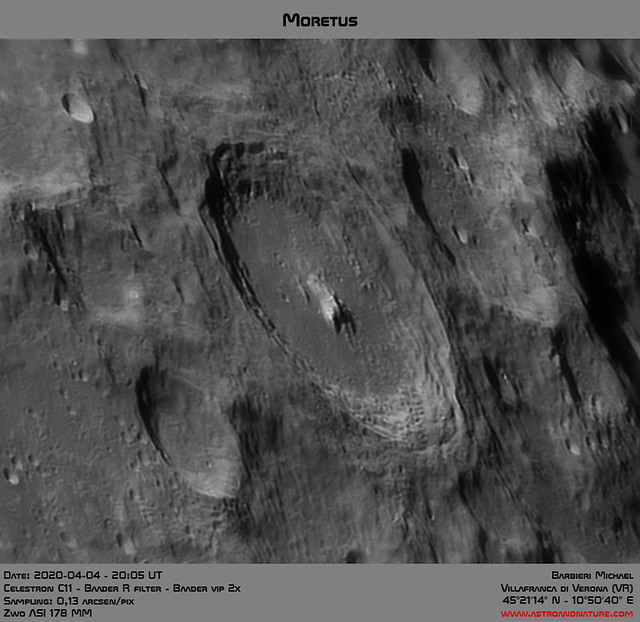Moon 4 aprile 2020
Alcune immagini lunari della serata del 4 aprile. Seeing generalmente scarso intorno al 5/10 e solo a tratti discreto, per questo motivo ho fatto filmati molto lunghi e usato per lo stack veramente pochi frame (solo 300). Nella prima foto si può vedere il grande cratere Clavius, probabilmente uno dei più bei crateri. Ha una dimensione di circa 225 Km e si presume si sia formato intorno ai 3.90 miliardi di anni fa. Al suo interno sono presenti numerosi crateri di svariate dimensioni e i più piccoli vengono solitamente utilizzati per stimare il seeing della serata. A fianco del cratere Clavius è presente il cratere Blancanus con un diametro di circa 106 Km. Nella seconda immagine è visibile il cratere Schiller con un diametro di circa 179 Km e la sua caratteristica forma a “nocciolina”. Ho potuto verificare che il dettaglio più piccolo risolto in questa foto è di circa 1 km. Infine la foto del cratere Moretus, forse la migliore della serie. La sua dimensione è di circa 114 Km e il picco centrale raggiunge la straordinaria altezza di 5 km. Clicca sulle immagini per vedere l’alta risoluzione.
Per l’acquisizione ho utilizzato il software firecapture, mentre per il post processing AS2, Registax e PS.
Dati di scatto
- Numero video: 1
- Formato .ser
- Frame catturati 15000
- Frame tenuti per lo stack 300
- campionamento: 0.13 arcsen/pix
- filtro rosso Baader CCD
Some lunar images of the evening of April 4th. Seeing generally poor around 5/10 and only at times good, for this reason I made very long films and used very few frames (only 300) for the stack. In the first photo you can see the large Clavius crater, probably one of the most beautiful craters. It has a size of about 225 km and is presumed to have formed around 3.90 billion years ago. Inside there are numerous craters of various sizes and the smaller ones are usually used to estimate the seeing of the evening. Next to the Clavius crater there is the Blancanus crater with a diameter of about 106 km. In the second image you can see the Schiller crater with a diameter of about 179 km and its characteristic “peanut” shape. I could verify that the smallest detail solved in this photo is about 1 km. Finally the photo of the Moretus crater, perhaps the best in the series. Its size is about 114 km and the central peak reaches an extraordinary height of 5 km. Click on the images to see the high resolution.
For the acquisition I used the firecapture software, while for the post processing AS2, Registax and PS.
shooting data
- Video number: 1
- format .ser
- Frames captured 15000
- Frames held for stack 300
- sampling: 0.13 arcsen / pix
- R filter Baader CCD
Setup
- Telescope: Celestron C11 XLT
- Camera: ZWO ASI 178 MM
- Mount: Skywatcher eq6 Pro
- Barlow: Baader Vip 1,2x
- Filter: R



